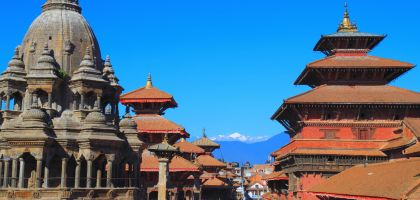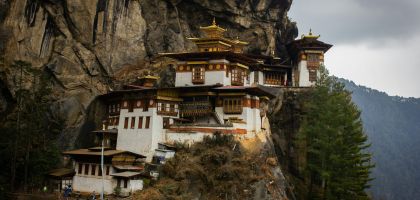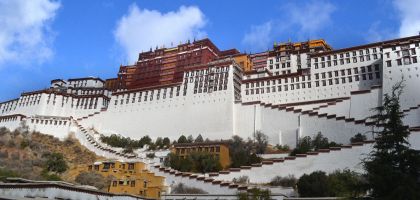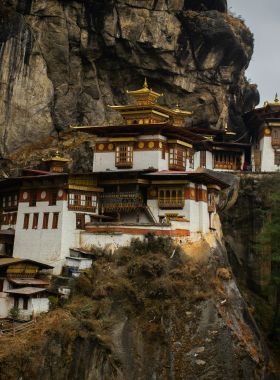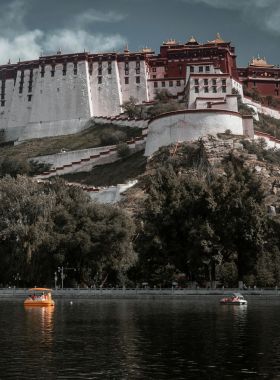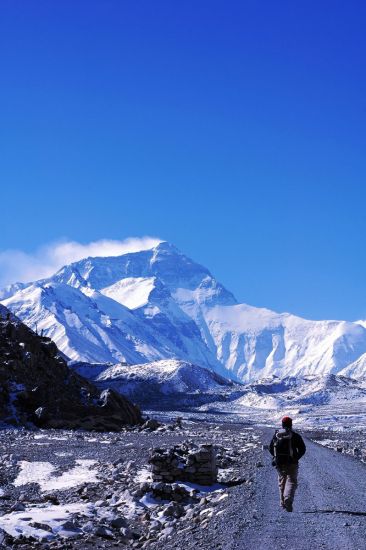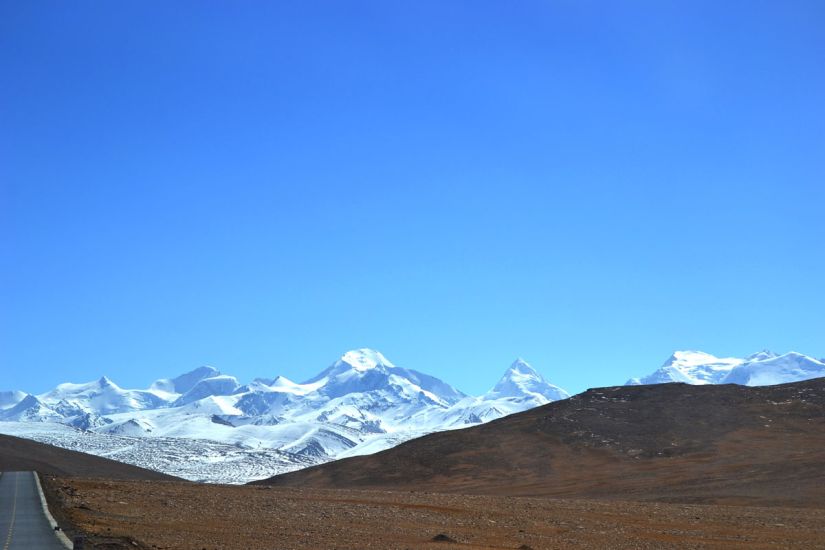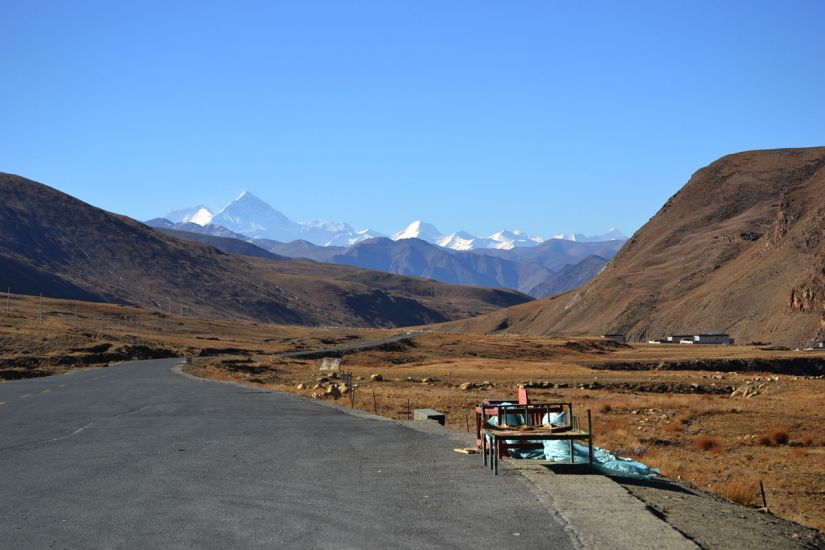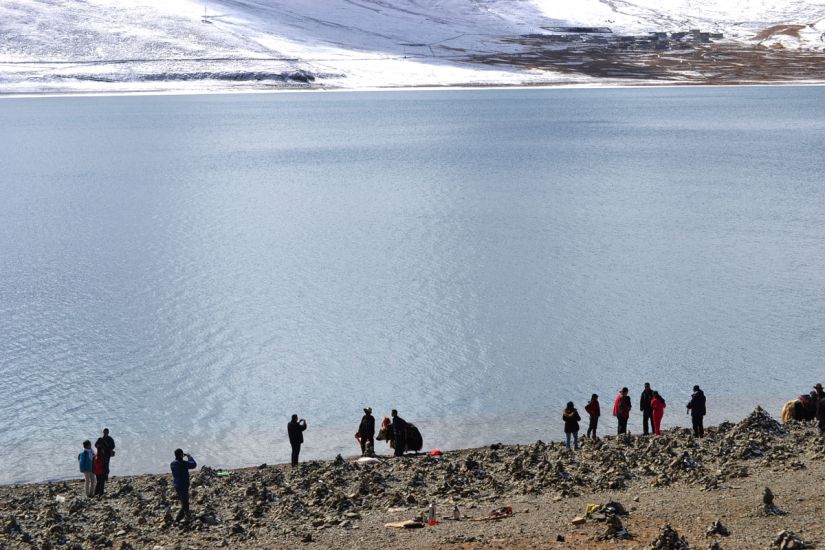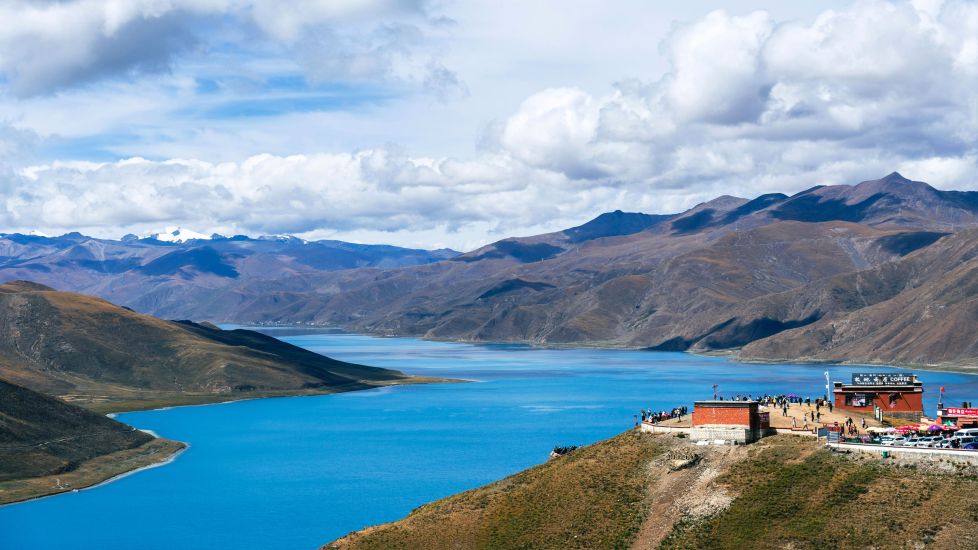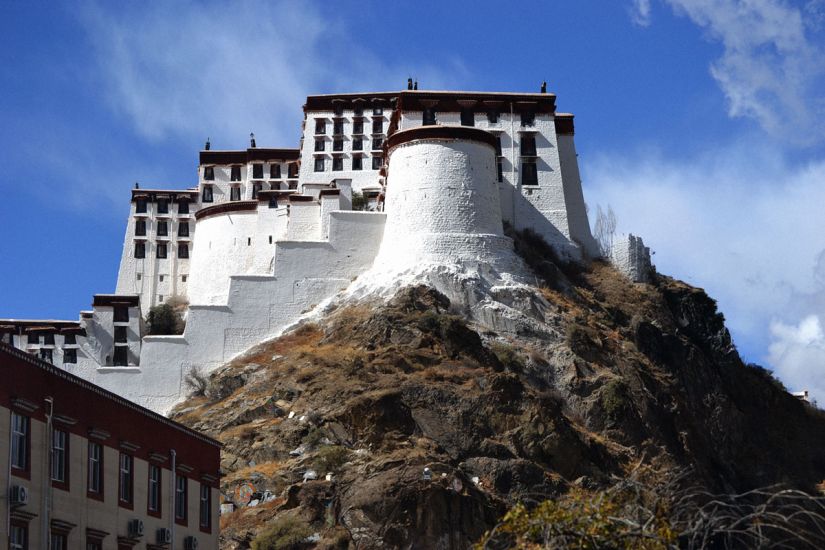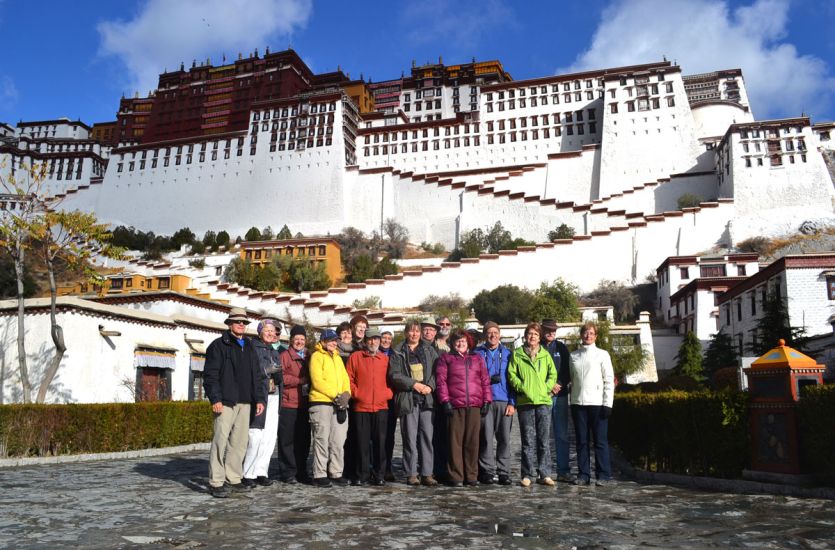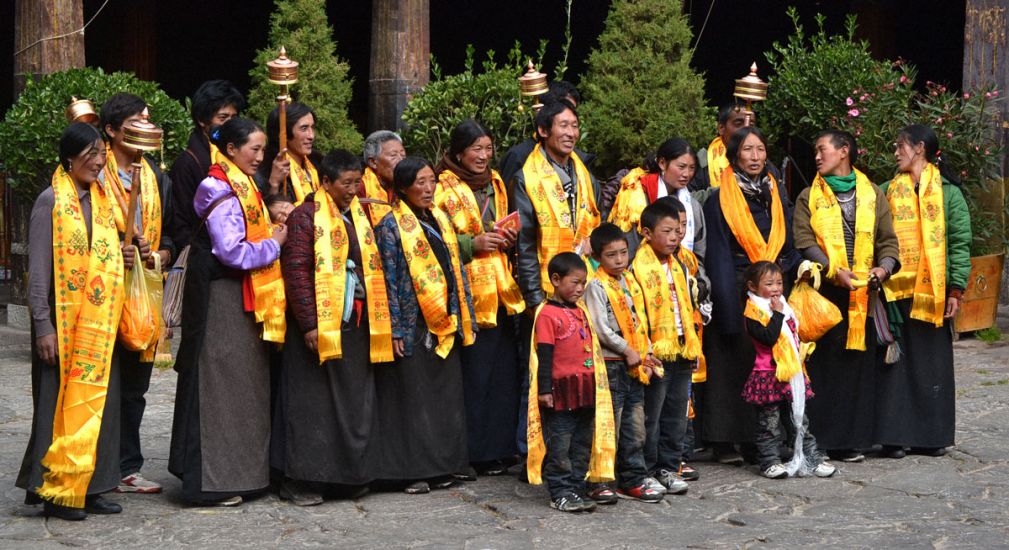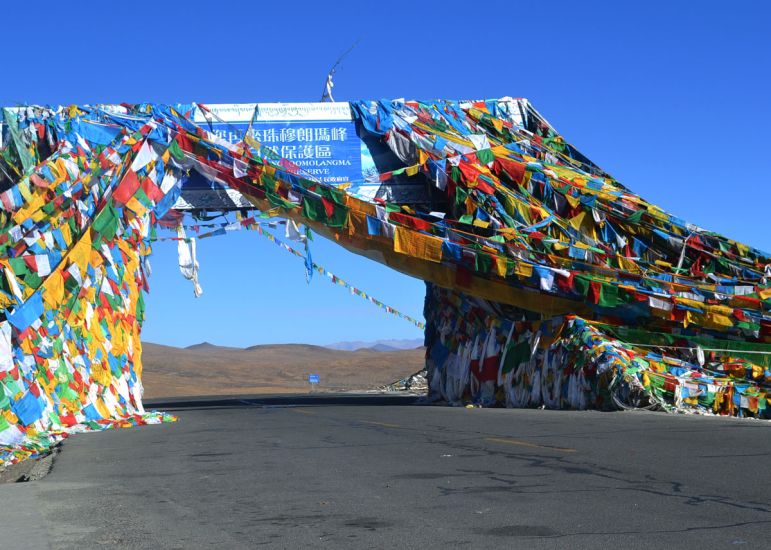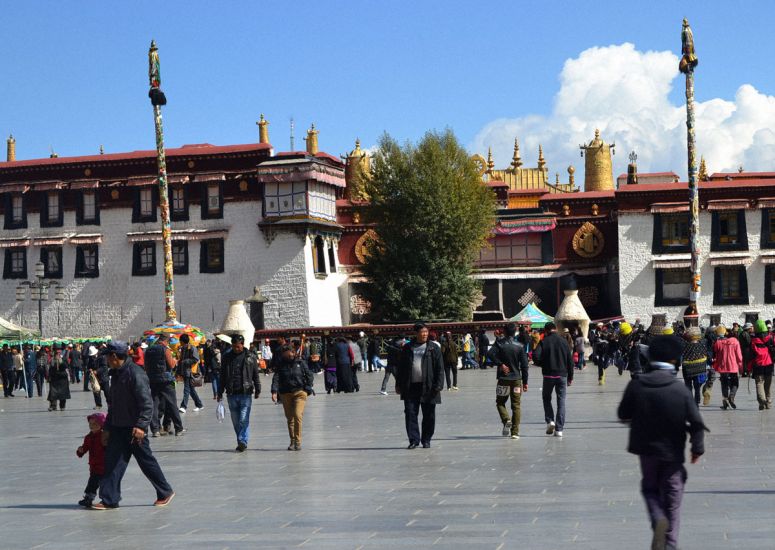Everest Base Camp Tibet
10 Days / Tibet
Activity
Difficulty Level
Destinations
Trip Start / End
Max Altitude
Accommodation
Travel Style
Best time to travel
Personalized Travel Advice

Dev Raj Nepal
+977 9851096523
Personalized Travel Advice

Dev Raj Nepal
+977 9851096523
Detailed Itinerary
01
DAY
01
Upon arrival at Gonggar Airport in Lhasa, you will be greeted warmly and transferred to your hotel. The scenic drive will take you to Lhasa, the spiritual heart of Tibet, where you can settle into your accommodation. Check-in, rest, and adjust to the altitude as you prepare for the exciting days ahead. The rest of the day will be at leisure, allowing you to acclimatize to the high-altitude environment before the start of this incredible Everest Base Camp Tibet tour.
Arrival in Lhasa – Flight to Gonggar Airport and Transfer to Hotel
Upon arrival at Gonggar Airport in Lhasa, you will be greeted warmly and transferred to your hotel. The scenic drive will take you to Lhasa, the spiritual heart of Tibet, where you can settle into your accommodation. Check-in, rest, and adjust to the altitude as you prepare for the exciting days ahead. The rest of the day will be at leisure, allowing you to acclimatize to the high-altitude environment before the start of this incredible Everest Base Camp Tibet tour.
02
DAY
02
Enjoy a full day of immersive sightseeing in Lhasa, the spiritual heart of Tibet. Your tour begins at the magnificent Potala Palace, an architectural marvel perched high on Marpo Ri Hill. This historic fortress served as the winter residence of the Dalai Lama for centuries and stands as a powerful symbol of Tibetan Buddhism and political history. Inside, you can admire the intricate murals, golden stupas, and sacred chapels that showcase Tibet’s rich cultural heritage.
Next, you will visit Sera Monastery, one of the three great monasteries of the Gelug or Yellow Sect tradition. Here, you may witness the lively debates among monks in the courtyard which is an ancient practice that sharpens their understanding of Buddhist philosophy. The monastery’s halls and frescoes tell stories of Tibetan spirituality and monastic life, offering a deep insight into the region’s religious fabric.
Your day concludes with a visit to Norbulingka, the Dalai Lama’s summer palace and a serene retreat surrounded by beautifully landscaped gardens. Stroll through the peaceful grounds, dotted with flowering plants, pavilions, and fountains, and soak in the tranquil atmosphere that contrasts with the bustling city. This visit offers a glimpse into the Dalai Lama’s life beyond the political and religious stage.
Lhasa Exploration
Enjoy a full day of immersive sightseeing in Lhasa, the spiritual heart of Tibet. Your tour begins at the magnificent Potala Palace, an architectural marvel perched high on Marpo Ri Hill. This historic fortress served as the winter residence of the Dalai Lama for centuries and stands as a powerful symbol of Tibetan Buddhism and political history. Inside, you can admire the intricate murals, golden stupas, and sacred chapels that showcase Tibet’s rich cultural heritage.
Next, you will visit Sera Monastery, one of the three great monasteries of the Gelug or Yellow Sect tradition. Here, you may witness the lively debates among monks in the courtyard which is an ancient practice that sharpens their understanding of Buddhist philosophy. The monastery’s halls and frescoes tell stories of Tibetan spirituality and monastic life, offering a deep insight into the region’s religious fabric.
Your day concludes with a visit to Norbulingka, the Dalai Lama’s summer palace and a serene retreat surrounded by beautifully landscaped gardens. Stroll through the peaceful grounds, dotted with flowering plants, pavilions, and fountains, and soak in the tranquil atmosphere that contrasts with the bustling city. This visit offers a glimpse into the Dalai Lama’s life beyond the political and religious stage.
03
DAY
03
Begin your day with a journey into the spiritual and cultural soul of Lhasa. Your first stop is Drepung Monastery, once the largest and most influential monastery in Tibet, home to thousands of monks at its peak. Nestled against the backdrop of rugged hills, its sprawling whitewashed complex exudes a sense of calm and timelessness. As you wander through its ancient halls and courtyards, you’ll gain insight into the monastic traditions that shaped Tibetan Buddhism for centuries.
Following that, make your way to the revered Jokhang Temple, a spiritual epicenter for Tibetan Buddhists. Located in the heart of Lhasa’s old town, this sacred temple houses the revered Jowo Shakyamuni statue and draws pilgrims from all over Tibet. The energy here is palpable, with the scent of incense in the air and the sound of chanting echoing through its ancient corridors.
The day ends with a walk along the vibrant Barkhor Street, which encircles the Jokhang Temple and forms part of the sacred kora (pilgrim path). This lively market street is rich in color and culture, and lined with prayer wheels, traditional Tibetan houses, and stalls selling everything from yak butter lamps to intricately woven thangkas. It’s the perfect place to soak in the rhythm of daily Tibetan life and pick up meaningful souvenirs.
Lhasa Exploration
Begin your day with a journey into the spiritual and cultural soul of Lhasa. Your first stop is Drepung Monastery, once the largest and most influential monastery in Tibet, home to thousands of monks at its peak. Nestled against the backdrop of rugged hills, its sprawling whitewashed complex exudes a sense of calm and timelessness. As you wander through its ancient halls and courtyards, you’ll gain insight into the monastic traditions that shaped Tibetan Buddhism for centuries.
Following that, make your way to the revered Jokhang Temple, a spiritual epicenter for Tibetan Buddhists. Located in the heart of Lhasa’s old town, this sacred temple houses the revered Jowo Shakyamuni statue and draws pilgrims from all over Tibet. The energy here is palpable, with the scent of incense in the air and the sound of chanting echoing through its ancient corridors.
The day ends with a walk along the vibrant Barkhor Street, which encircles the Jokhang Temple and forms part of the sacred kora (pilgrim path). This lively market street is rich in color and culture, and lined with prayer wheels, traditional Tibetan houses, and stalls selling everything from yak butter lamps to intricately woven thangkas. It’s the perfect place to soak in the rhythm of daily Tibetan life and pick up meaningful souvenirs.
04
DAY
04
Your journey today takes you from Lhasa to the historic town of Gyantse, following one of the most scenic overland routes in Tibet. Along the way, you’ll cross two high mountain passes: Kamba La (4,794m) and Karo La (5,050m), each offering sweeping views of the rugged Himalayan terrain. A highlight of the drive is the breathtaking sight of Yamdrok Tso, a vast turquoise lake that winds through the mountains like a ribbon of light. By afternoon, you’ll arrive in Gyantse, a charming town that has retained much of its traditional Tibetan character. Check into your hotel and take time to relax after the long but rewarding drive.
Lhasa to Gyantse
Your journey today takes you from Lhasa to the historic town of Gyantse, following one of the most scenic overland routes in Tibet. Along the way, you’ll cross two high mountain passes: Kamba La (4,794m) and Karo La (5,050m), each offering sweeping views of the rugged Himalayan terrain. A highlight of the drive is the breathtaking sight of Yamdrok Tso, a vast turquoise lake that winds through the mountains like a ribbon of light. By afternoon, you’ll arrive in Gyantse, a charming town that has retained much of its traditional Tibetan character. Check into your hotel and take time to relax after the long but rewarding drive.
05
DAY
05
This morning, explore Gyantse’s highlights, including the Pelkor Chode Monastery, famous for its Kumbum Stupa, a unique multi-storied structure that houses thousands of Buddhist statues and paintings. Afterward, take a rickshaw ride back to the parking lot, collect your luggage, and continue your journey to Shigatse. Upon arrival in Shigatse, check into your hotel and refresh before heading to Tashilunbo Monastery, the principal seat of the Panchen Lama, the second-highest religious authority in Tibet. The monastery’s impressive architecture and serene environment will provide a tranquil end to the day.
Gyantse to Shigatse
This morning, explore Gyantse’s highlights, including the Pelkor Chode Monastery, famous for its Kumbum Stupa, a unique multi-storied structure that houses thousands of Buddhist statues and paintings. Afterward, take a rickshaw ride back to the parking lot, collect your luggage, and continue your journey to Shigatse. Upon arrival in Shigatse, check into your hotel and refresh before heading to Tashilunbo Monastery, the principal seat of the Panchen Lama, the second-highest religious authority in Tibet. The monastery’s impressive architecture and serene environment will provide a tranquil end to the day.
06
DAY
06
Drive from Shigatse to Shegar (New Tingri), a journey that takes you over two high mountain passes: Tropu La (16,236 ft) and Gyatso La (17,122 ft). These passes offer dramatic views of Tibet’s towering peaks, including Everest in the distance. After arriving in Shegar, check into your hotel for a rest before visiting the historic Shegar Dzong, the former capital of the Tingri region. If time permits, explore Shegar Chode Monastery, a small yet important Gelugpa institution.
Shigatse to Shegar
Drive from Shigatse to Shegar (New Tingri), a journey that takes you over two high mountain passes: Tropu La (16,236 ft) and Gyatso La (17,122 ft). These passes offer dramatic views of Tibet’s towering peaks, including Everest in the distance. After arriving in Shegar, check into your hotel for a rest before visiting the historic Shegar Dzong, the former capital of the Tingri region. If time permits, explore Shegar Chode Monastery, a small yet important Gelugpa institution.
07
DAY
07
In the morning, set out on a dramatic drive from Shegar to Dza Rongbuk Monastery, the world’s highest monastery, nestled at the foot of Mount Everest. The journey takes you over the windswept Pang La pass (5,120m), where, on a clear day, you’ll be greeted with an awe-inspiring panorama of the eastern Himalayas, including Everest, Makalu, Lhotse, and Cho Oyu, four of the world’s highest peaks. The route winds along rugged dirt roads, passing through remote highland settlements and offering glimpses of traditional Tibetan life.
Upon reaching Rongbuk, check into the guesthouse or simple monastery accommodation. After a short rest, you’ll embark on a gentle one-hour walk to Everest Base Camp (5,200m), following a barren yet stunning landscape dominated by snow-capped peaks and glacial valleys. Standing at base camp, take in the majestic north face of Everest, an unforgettable highlight of the journey. After some time to soak in the views and atmosphere, return to Rongbuk for the night.
Shegar to Rongbuk Monastery- EBC
In the morning, set out on a dramatic drive from Shegar to Dza Rongbuk Monastery, the world’s highest monastery, nestled at the foot of Mount Everest. The journey takes you over the windswept Pang La pass (5,120m), where, on a clear day, you’ll be greeted with an awe-inspiring panorama of the eastern Himalayas, including Everest, Makalu, Lhotse, and Cho Oyu, four of the world’s highest peaks. The route winds along rugged dirt roads, passing through remote highland settlements and offering glimpses of traditional Tibetan life.
Upon reaching Rongbuk, check into the guesthouse or simple monastery accommodation. After a short rest, you’ll embark on a gentle one-hour walk to Everest Base Camp (5,200m), following a barren yet stunning landscape dominated by snow-capped peaks and glacial valleys. Standing at base camp, take in the majestic north face of Everest, an unforgettable highlight of the journey. After some time to soak in the views and atmosphere, return to Rongbuk for the night.
08
DAY
08
Following your hearty breakfast, retrace your journey back to Xegar, then continue on to Shigatse. The drive takes you through stunning landscapes and gives you another opportunity to appreciate the grandeur of the Tibetan plateau. Upon arrival in Shigatse, relax at your hotel, reflecting on the incredible journey you’ve had so far.
Rongbuk to Segar to Shigatse
Following your hearty breakfast, retrace your journey back to Xegar, then continue on to Shigatse. The drive takes you through stunning landscapes and gives you another opportunity to appreciate the grandeur of the Tibetan plateau. Upon arrival in Shigatse, relax at your hotel, reflecting on the incredible journey you’ve had so far.
09
DAY
09
This day, we will drive back to Lhasa via the New Road, a scenic route offering different views from the road you traveled on the way in. En route, stop at Yungdrungling Monastery, an important Bonpo Buddhist site known for its ancient scriptures and religious practices. Continue your journey back to Lhasa, where you can relax and unwind after the long drive.
Shigatse to Lhasa
This day, we will drive back to Lhasa via the New Road, a scenic route offering different views from the road you traveled on the way in. En route, stop at Yungdrungling Monastery, an important Bonpo Buddhist site known for its ancient scriptures and religious practices. Continue your journey back to Lhasa, where you can relax and unwind after the long drive.
10
DAY
10
Your Everest Base Camp Tibet tour concludes here. After breakfast, you’ll be transferred to Gonggar Airport for your onward flight. With hearts full of memories and a deeper connection to the land of snow, your unforgettable Tibet adventure comes to a close.
Departure
Your Everest Base Camp Tibet tour concludes here. After breakfast, you’ll be transferred to Gonggar Airport for your onward flight. With hearts full of memories and a deeper connection to the land of snow, your unforgettable Tibet adventure comes to a close.
Tour Cost
At High Asia Tours, we know that understanding tour costs is essential for planning your trip. Due to variables such as accommodation choices, meal plans, transportation options, group size, and seasonal demand, providing an exact price upfront is challenging.
To assist you, we offer a starting price to give a general idea of the cost:
The starting cost for this tour is
Includes / Excludes
Inclusions
-
Accommodation on twin sharing.
-
Daily Breakfast.
-
All transfers and sightseeing by a private air conditioned car or coach.
-
Sightseeing admission fees.
-
English speaking Tour Guide.
-
Tibet Travel Permit.
Exclusions
-
International and internal air fares.
-
Airport Taxes.
-
Chinese visa fee.
-
Lunch and dinner except as indicated.
-
Travel & Health Insurance.
-
All extra expenses caused due to nature or unforeseen events.
-
Excess baggage charges.
-
Optional tipping to local staffs, hotels etc.
-
Items of a personal nature (sodas, alcoholic beverages, laundry, telephone etc)
Trip Info
Everest Base Camp Tibet Tour
The Everest Base Camp Tibet tour offers a rare opportunity to journey across the vast and remote landscapes of the Tibetan Plateau while tracing the cultural and spiritual legacy of Tibetan Buddhism. Starting in Lhasa, you will explore the city’s deeply sacred landmarks, including the towering Potala Palace, the revered Jokhang Temple, and some of Tibet’s most important monastic centers. As you drive across central Tibet, you’ll witness dramatic shifts in scenery, from sweeping valleys and alpine lakes to windswept high passes adorned with prayer flags. Along the way, encounters with local pilgrims, prayer wheels spinning in temple courtyards, and quiet hillside villages provide insight into everyday life on the plateau.
The route includes visits to the culturally significant towns of Gyantse and Shigatse, each home to important monuments such as the multi-tiered Kumbum Stupa and the seat of the Panchen Lama at Tashilhunpo Monastery. The journey continues toward Shegar and then Rongbuk, the site of the world’s highest monastery. A highlight of the Everest Base Camp Tibet tour is the panoramic view from Pang La Pass, where five of the world’s tallest peaks line the horizon. From Rongbuk, a short trek brings you to Everest Base Camp, located at 5,200 meters, where the north face of Mount Everest rises sharply into the sky. This journey not only reaches one of the world’s most iconic destinations but also reveals the deep spiritual rhythms and raw beauty of Tibet.
Everest Base Camp in Tibet offers a vastly different perspective of the world’s highest mountain. It is more remote, dramatic, and accessible by road. Located at 5,200 meters above sea level, the Tibetan base camp lies beneath the imposing north face of Mount Everest, a view that is both direct and towering, offering a full sense of the mountain’s scale and power. Unlike the Nepal side, which requires a strenuous multi-day trek, the Everest Base Camp Tibet tour allows travelers to reach this iconic site by vehicle, making it ideal for those seeking the experience without long trekking days. The landscape here is stark and beautiful, with broad valleys, glacier-fed rivers, and windswept plains framed by Himalayan giants like Cho Oyu and Shishapangma. On clear mornings and evenings, the golden light on Everest’s summit is a spectacle of quiet majesty.
Adding to the experience is the nearby Rongbuk Monastery, considered the highest monastery in the world, where the thin air carries the sound of wind and prayer. Built in the early 20th century, Rongbuk remains a spiritual anchor in this high-altitude wilderness, offering a glimpse into the lives of nuns and monks who live and worship here. The base camp itself serves as a seasonal launching point for mountaineering expeditions, and while tourists cannot access the climbers’ camp beyond the restricted zone, the viewpoint near Rongbuk offers an unforgettable panorama. Fewer crowds, wide-open space, and a profound sense of isolation make the Everest Base Camp Tibet experience unlike anywhere else on earth.
The best time to do this Everest Base Camp Tibet tour is during the spring, summer and autumn months, from April to October. These seasons offer the most favorable weather conditions, ensuring a comfortable and enjoyable journey.
Spring (April to June)
Spring in Tibet brings clear skies, mild temperatures, and stunning landscapes as the region begins to bloom with vibrant colors. This is the perfect time for sightseeing and outdoor activities, with the weather being ideal for exploring Tibet’s high-altitude wonders. The snow-capped mountains are particularly striking during these months.
Autumn (September to October)
Autumn is another excellent time to visit, as the temperatures remain pleasant and the landscapes are painted in golden hues. This season marks the harvest period, and the weather is perfect for trekking, photography, and visiting Tibet’s monasteries and sacred sites. The clear skies and crisp air enhance the beauty of Tibet’s natural wonders.
Summer (July to August)
Though summer is a popular time to visit Tibet due to warmer temperatures, it coincides with the monsoon season. Expect occasional rainfall and cloudy weather, which can make some trekking routes less accessible. However, the lush, green landscapes and fewer tourists make it an appealing option for some travelers.
Private Vehicles
Throughout the trip, private vehicles will be used for transfers and sightseeing. These include comfortable cars or SUVs, which are good for navigating both urban and rural areas. These vehicles are chosen for their comfort and reliability, ensuring a smooth and enjoyable journey between destinations. They are equipped to handle various road conditions and provide a high level of convenience for travelers.
Minivans or Buses
For group travel of more than 8 people Buses will be used and for a smaller group of people, Minivans can be used. These vehicles are suitable for accommodating larger groups and offer ample space for passengers and luggage. Equipped with air conditioning and comfortable seating, these vehicles are designed to enhance travel comfort over longer distances. They also offer better stability and space for scenic drives and excursions.
Food is an essential part of any Tibet tour, offering a blend of traditional Tibetan flavors and familiar Western options. Tibetan cuisine is simple yet hearty, designed to provide warmth and energy in the high-altitude environment. A staple food is tsampa, a roasted barley flour often mixed with butter tea to create a dense, nutritious meal. Speaking of butter tea (po cha), this salty, yak butter-infused drink is a Tibetan favorite, providing hydration in the dry mountain air. For those who enjoy noodles, thukpa and thenthuk are comforting bowls of hand-pulled noodles served in a rich broth with vegetables and meat. Another must-try dish is momos, Tibetan-style dumplings stuffed with meat or vegetables, often served with a spicy dipping sauce. Yak meat is widely used in various dishes, from dried yak jerky to flavorful stews.
While traditional Tibetan food is a highlight, travelers will also find a variety of Western dishes in major cities like Lhasa and Shigatse. Many hotels and restaurants cater to international visitors, offering familiar meals such as pasta, pizza, sandwiches, and even a hearty Western breakfast with eggs, toast, and coffee. Bakeries serving fresh bread and pastries are also common, providing a nice break from the local cuisine. Whether you’re sipping butter tea in a monastery, savoring a steaming bowl of noodles, or enjoying a familiar meal in a cozy café, food in Tibet adds a rich cultural and comforting flavor to your journey.
During your Tibet tour, accommodations range from comfortable hotels in major cities to simple guesthouses in remote areas, each offering a unique experience. In Lhasa, Shigatse, and Gyantse, travelers can find a selection of three- to five-star hotels equipped with modern amenities such as heating, Wi-Fi, and private bathrooms. Many of these hotels blend Tibetan charm with contemporary comfort, featuring traditional décor and warm hospitality.
As you travel to more remote regions, the accommodation options become simpler. In places like Shegar and Rongbuk Monastery, guesthouses and basic lodges are the primary choices. These accommodations may have shared bathrooms, limited hot water, and basic heating, but they offer an authentic experience close to nature. At Rongbuk, the highest monastery in the world, travelers can stay in a monastery guesthouse or a simple tented camp, allowing for an unforgettable night near Everest Base Camp.
While luxury options are available in larger towns, it’s essential to be prepared for basic facilities in high-altitude areas. However, the warm hospitality and breathtaking views more than make up for the simplicity. Whether you’re enjoying a comfortable stay in Lhasa or embracing the rugged charm of a remote guesthouse, the variety of accommodations adds to the adventure of exploring Tibet.
Visa and Permit Requirements for the Everest Base Camp Tibet Tour
Chinese Visa
To enter Tibet via Lhasa, every traveler must obtain a Chinese tourist visa (L visa) in advance. This visa is issued by the Chinese embassy or consulate in your home country or country of residence. The application process typically requires submitting your passport, a completed visa form, photos, and sometimes proof of travel plans. It is important to apply for the visa well ahead of your planned departure date, as processing times may vary depending on your location. Without a valid Chinese visa, entry into Tibet and China will be denied.
For more information on this, check China Consular Affairs
Tibet Travel Permit
Once you arrive in China with your visa, you will need a Tibet Travel Permit to legally enter Tibet Autonomous Region. This permit is issued by the Tibet Tourism Bureau and is mandatory for all foreign travelers visiting Tibet. The permit includes your personal details and travel itinerary. Importantly, the Tibet Travel Permit is not something you can apply for on your own and it must be arranged through a licensed tour operator like us. Our team will handle this for you, securing your permit before you begin your journey in Lhasa.
Alien’s Travel Permit
Certain areas of Tibet, including regions like Shigatse, Gyantse, and Everest Base Camp, are considered restricted and require an additional document called the Alien’s Travel Permit. This permit grants access to these controlled zones and is also arranged by us. Carrying this permit is essential for your travel beyond Lhasa and ensures compliance with local regulations.
Mount Everest National Park Entry Permit
For your visit to the Everest Base Camp area itself, you will need the Mount Everest National Park Entry Permit. This permit allows you to enter the protected national park zone and experience the breathtaking scenery around Everest. Like the other permits, this is organized on your behalf by our team to ensure a seamless travel experience.
Preparing the right gear and clothing is key to enjoying your Everest Base Camp Tibet tour comfortably and safely. Here’s a comprehensive packing list to help you get ready:
Clothing
- Warm, layered clothing: thermal base layers, fleece jackets, and insulated outerwear
- Waterproof and windproof jacket and pants to protect against sudden weather changes
- Comfortable trekking pants and shirts (quick-dry materials recommended)
- Hat and gloves (preferably insulated) for cold mornings and evenings
- Sun hat and sunglasses with UV protection to shield from strong high-altitude sun
- Sturdy, broken-in hiking boots with good ankle support
- Casual clothes for evenings or rest days in towns and hotels
- Warm socks and extra pairs to keep feet dry and warm
Gear and Accessories
- Daypack for carrying essentials on short hikes
- Reusable water bottle or hydration system to stay hydrated at altitude
- Headlamp or flashlight with extra batteries for remote accommodations
- Personal toiletries including biodegradable soap and hand sanitizer
- Sunscreen with high SPF and lip balm with UV protection
- Basic first aid kit with blister treatment, painkillers, and altitude sickness medication (consult your doctor)
- Travel adapter for charging electronic devices
Documents and Money
- Valid passport with Chinese visa and necessary permits (carry copies too)
- Travel insurance documents covering high-altitude trekking
- Cash in Chinese Yuan (CNY) for purchases in remote areas (ATMs are limited)
The Everest Base Camp Tibet tour is suitable for travelers with a reasonable level of fitness and a spirit of curiosity. Unlike the more physically demanding trek on the Nepal side, this journey brings you to the base camp largely by road, with gradual altitude gain and minimal physical strain. Most days involve scenic drives, cultural exploration, and short walks, rather than extended hiking.
That said, the elevation is significant. You’ll begin at around 3,600 meters in Lhasa and reach over 5,200 meters at Everest Base Camp. While the walk from Rongbuk Monastery to base camp is only about an hour round-trip on a dirt path, the thin mountain air can make even gentle activity feel more intense. For this reason, it’s important to arrive with a bit of preparation.
No specialized training is needed, but staying active in the weeks before your departure will help. We recommend building a habit of walking daily, ideally on stairs or gentle inclines. Focus on cardiovascular fitness and breathing control rather than strength. Also, if you have any medical concerns, especially related to heart or lung conditions, it’s wise to consult your doctor before the trip.
Beyond physical readiness, mental preparation matters too. High-altitude travel can bring mild discomfort, such as headaches or disrupted sleep in the first days. Being well-rested before your trip, staying hydrated, and pacing yourself once in Tibet can all make a big difference. And of course, our experienced guides are there to help you adjust, monitor your well-being, and make the journey as smooth as possible.
Understanding Altitude in Tibet
The Everest Base Camp Tibet tour takes you through some of the highest inhabited places on Earth. Starting from Lhasa at 3,650 meters (11,975 feet), the journey ascends gradually to Everest Base Camp at 5,200 meters (17,060 feet). At these elevations, the air is thinner, containing less oxygen, which can affect how your body functions and feels.
How We Ensure Safe Acclimatization
Our itinerary is carefully designed to help your body adjust safely to the increasing altitude. By allowing rest and acclimatization days in key locations such as Lhasa and Shigatse, you ascend steadily rather than rapidly. This gradual pace reduces the risk of altitude sickness and improves your overall comfort throughout the trip.
Recognizing Symptoms of Altitude Sickness
Altitude sickness can cause headaches, dizziness, nausea, and shortness of breath. While symptoms are often mild, it’s important to listen to your body and communicate any discomfort to your guides. Our experienced guide closely monitors all travelers and can modify the schedule if necessary to keep everyone safe and healthy.
Tips for a Comfortable Journey at High Altitude
To help your body acclimate more easily, drink plenty of water, avoid alcohol during the first few days, and take it easy in the initial stages of your journey. Getting enough rest and eating light meals also supports acclimatization. If you plan ahead and follow these guidelines, you’ll be ready to enjoy the breathtaking landscapes and cultural experiences Tibet has to offer.
Breathtaking Scenery
Prepare to be awed by the dramatic Tibetan Plateau, snow-capped mountains, serene lakes like Yamdrok Tso, and vast open spaces. From the towering peaks of Mount Everest to the tranquil beauty of remote valleys, the landscapes here are unlike anywhere else on Earth.
Spiritual and Cultural Immersion
Tibet is deeply rooted in its Buddhist heritage. Expect to visit iconic landmarks like the Potala Palace, Jokhang Temple, and Drepung Monastery, each brimming with rich history and religious significance. The peaceful atmosphere of these sacred sites will offer you moments of reflection and awe.
Unique Culinary Delights
Tibetan food is hearty and nourishing, perfect for the high-altitude climate. Savor dishes like momos (dumplings), thukpa (noodle soup), and tsampa (roasted barley flour), along with the famous butter tea. While traditional Tibetan cuisine will dominate your meals, you’ll also find Western food options available in larger towns, ensuring a balanced culinary experience.
Authentic Accommodations & Warm Hospitality
Expect a mix of accommodation styles throughout your tour. In larger cities like Lhasa, you’ll find comfortable hotels with modern amenities. In remote areas such as Rongbuk, accommodations will be simpler, offering guesthouses or monastery stays that bring you closer to Tibet’s unique culture and natural beauty. Despite the rugged terrain, Tibetans are known for their warm and welcoming hospitality. Whether you’re enjoying a simple meal in a remote village or exploring a sacred temple, you’ll find the people of Tibet to be kind and eager to share their rich culture with visitors.
High-Altitude Conditions
Tibet’s high-altitude environment means you’ll be traveling at elevations over 12,000 feet. Be prepared for potential altitude sickness, especially in areas like Rongbuk Monastery and Everest Base Camp. Your body may need time to adjust, and it’s important to stay hydrated and take it easy as you acclimatize.
Traveling to Tibet provides a fantastic opportunity to witness extraordinary landscapes and visit sacred landmarks. However, it’s also an opportunity to experience a deeply spiritual and resilient culture. As guests in this unique and sensitive region, it’s essential that we travel with care, respect, and awareness.
One of the most important aspects of responsible travel in Tibet is understanding that religion and daily life are deeply intertwined here. Monasteries, though ornate, are also places of prayer and practice. When entering religious sites, dress modestly, remove your hat, and speak quietly. Never touch sacred objects or point your feet toward altars or statues. Always walk clockwise around stupas and prayer wheels unless otherwise indicated.
Photography is welcome in many places, but always ask before taking photos of monks, local people, or inside temples. In some monasteries, photography is restricted or may require a small fee.
While it’s natural to be curious about local life, be mindful that Tibetans have experienced significant political and cultural changes in recent decades. Avoid asking questions or initiating conversations about politics. Your guides are well-versed in what is appropriate to discuss and will help navigate any sensitive topics.
We also encourage responsible environmental behavior. Littering is strictly discouraged, and access to waste disposal in remote areas is limited. Carry reusable water bottles, reduce single-use plastics, and dispose of any trash responsibly. Respect the fragile ecosystems you pass through, especially at high altitudes.
Lastly, consider supporting the local economy in small but meaningful ways. Purchasing handmade crafts, eating in locally run restaurants, and showing kindness to the people who share their homeland with you.
FAQs
Personalized Travel Advice

Dev Raj Nepal
+977 9851096523
